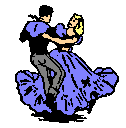WHAT IS ROUND DANCING?
by Tim Eum


Round Dancing is fun.
Round dancers spend time with their partners and friends, enjoying and
moving rhythmically to great music. Round dancers participate purely for the fun
of it--there are no competitions, no judges, no dance awards. Round dancers are
rewarded with lifelong friendships.
Round Dancing is an exciting social activity.
Round dancers form clubs and gather together to dance at places like
schools, community centers, church recreation halls, YMCA's and fraternal
organization halls. Most clubs only charge $4 or $5 per dancer for the entire
evening, and most allow spectators to watch for free. Often clubs combine to put
on even larger and longer events. There are clubs, and round dance events all
over the world. Round dancers can even spend an entire week round dancing at
special mountain resorts or romantic ocean cruises.
Round Dancing is choreographed, cued couples dancing.
Round dancing is like ballroom dancing and uses ballroom figures, but there
are two major differences--it is choreographed ahead of time and then cued to
the dancers in a manner similar to the way square dance callers direct square
dancers.
Choreographers choose wonderful music and then choose the different movements
and figures to fit the music exactly. If the music swells and pauses briefly,
then a dance step that rises and stretches is put into that place. If there is a
little syncopation in another part of the song, then a quick little step is
inserted. The creation of a piece of choreography is like designing the interior
of a home, with every piece of furniture and artwork in just the right place to
give the best feel and enjoyment. Dances have been choreographed to a myriad of
rhythms--waltz, two-step, cha-cha, rumba, jive/swing, foxtrot, tango, bolero,
mambo, samba, merengue, salsa, west coast swing, paso doble, quickstep and
others.
The "Cuer" or Round Dance Leader, stands with a microphone and the sound
equipment at one side of a dance hall. As the music plays, and just ahead of
when the dancers must respond, the cuer names each dance figure of the
choreography to be done in proper order. Since dances are cued, dancers need not
memorize choreography and can thus dance hundreds of different routines. In a
two hour club night, the dancers could typically dance over thirty choreographed
dances.
Since all the dancers are doing the same figures in the same direction at the
same time (or at least are supposed to), the choreography can become quite
elaborate. The dancers can move great distances with many changes of direction
without fear of running into other couples. ROUNDLAB, the International
Association of Round Dance Teachers Inc., has defined six phases of dance
figures with phase one (I) generally being the easiest in difficulty and phase
six (VI) comprising the most difficult fisgures. Most round dance clubs do not
try to do all phase levels and thus as a dancer you can choose clubs that cater
to the level that you are most comfortable at.
Couples form up and generally progress counterclockwise in a circle around the
dance floor--thus the name "Round Dancing".
Round Dancing is part of the Modern Square Dance Movement.
Modern Round Dancing grew along with Modern Square Dancing through the
second half of the twentieth century. Although pure round dance clubs exists as
do pure square dance clubs, there are many clubs that offer both in what is
called a two by two program. A caller will call square dance patter for about 6
minutes and then sign a singing call for about 4 minutes. Then a cuer will cue
two round dance routines, talking about 8 minutes. Then the caller comes up
again. Then the cuer and so on until the evening has been fulfilled. There are
State and National Square and Round Dance Conventions where both activities are
conducted. Many local caller associations and round dance teacher associations
are combined as one organization. There continues to be mutual symbiosis between
square and round dancing. A great many square dancers first learn of round
dancing from the two by two clubs and conventions and thus many round dancers
were at first square dancers. Since round dance music is of all types (big
bands, rock & roll, easy listening, and many others) it complements what is
predominately the country western square dance sound at square dance events.
Square dancers tend to retain the "whoop and holler" spirit of dancing, while
round dancers tend to dance with greater precision and thus help to improve the
overall smoothness experienced by all in the intertwining square dance
movements. Round dancing really does "ROUND" out the square dance experience.
Round Dancing is healthy exercise.
Round Dancing is an active activity. Most of the time, you will be on the
floor dancing. There are short breaks and most leaders allow you to rest
whenever you want -- but the norm is to dance. The more you do it, the more you
can do it. Not only does your heart pump, but your mind is also exercised in
trying to remember how to do all the figures that the cuer cues.